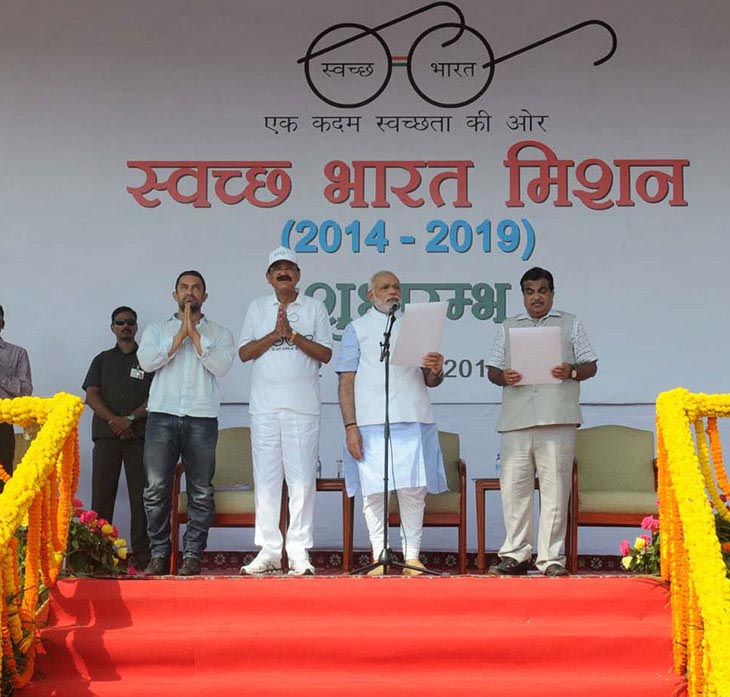Despite reports of coercion to achieve targets, the Swachh Bharat Mission seems to have been successful as data reveals that 99 percent of cities in India have been declared open defecation free.
By Shaheen Parween
Travel by train anywhere in India and the one sight that invariably meets one’s eyes is people defecating along the railway tracks nonchalantly, much to the wonder of foreigners visiting the country. In a sign of changing times, latest data from the Ministry of Housing and Urban Affairs reports that 99 percent of Indian cities have been declared open defecation free (ODF). However, due to the pandemic, the survey in cities in West Bengal is still pending.
In order to accelerate the efforts to achieve universal sanitation coverage, Prime Minister Narendra Modi launched the Swachh Bharat Mission (SBM) on October 2, 2014. It comprises two missions Swachh Bharat (Gramin) under the Ministry of Drinking Water and Sanitisation and Swachh Bharat (Urban) under the Ministry of Housing and Urban Affairs.
Under SBM, all villages, gram panchayats, districts, states and Union Territories declared themselves ODF by October 2, 2019, the 150th birth anniversary of Mahatma Gandhi, by constructing over 100 million toilets in rural India.
The objectives of SBM are:
- To prompt an improvement in the general quality of life in rural and urban areas by promoting cleanliness, hygiene and eliminating open defecation.
- To speed up the sanitation coverage through construction of individual household toilets, public toilets and community toilets, along with provisions for water storage and hand washing to achieve the vision of SBM by October 2, 2019.
- To encourage individuals and village development institutions to adopt sustainable sanitation practices and facilities through awareness creation and health education. The Mission aims to bring about a positive behavioural change regarding healthy sanitation practices in both rural and urban areas. Creating awareness about sanitation and its linkage with public health is also one of the top priorities in SBM.
- To encourage cost effective and suitable technologies for ecologically safe and sustainable sanitation. Increasing modern and scientific municipal solid and liquid waste management is another area where SBM has been capitalised.
- To encourage a positive impact on gender and promote social inclusion by improving sanitation, especially in marginalised communities.
- To increase the capacity to create an enabling environment for private sector participation in Capex (capital expenditure) and Open (operation and maintenance).
The approach is to make Swachh Bharat or a cleaner India through a massive mass movement, involving everyone in cleaning homes, workplaces, villages, cities, and surroundings. Open defecation or the act of relieving oneself in the open or the improper disposal of excreta is a cause of public health concern worldwide. Studies reveal that about one billion people engage in this practice worldwide, leading to problems like water contamination and the spread of diseases, including childhood malnutrition.
The practice of open defecation, however, must not be equated with poverty. Wealth and the use of latrines are not proportional to each other.
Rather, it has been said that preference for open defecation or dislike of simple pit latrines is one of the significant reasons for open defecation in India.
In fact, it may vary depending on religious beliefs and the social group one belongs to.
The first national campaign to improve sanitation in India was the Central Rural Sanitation Programme (CRSP), launched in 1986, “primarily with the objective of improving the quality of life of the rural people and also to provide privacy and dignity to women”. The programme also aimed to provide 25 percent of the rural population with improved sanitation facilities by the end of the decade. The programme mainly focused on latrine construction, but many of these remained unused.
In 1999, CRSP was restructured and rebranded as the Total Sanitation Campaign (TSC) by the government. Taking lessons from the disappointing results of CRSP, TSC aimed at encouraging a change in behaviour and generating a demand for toilets. In 2012, the Nirmal Bharat Abhiyan replaced TSC with the aim of providing access to improved sanitation facilities for all rural households by 2022 and enabling all villages to reach ODF status.
The success of the Swachh Bharat Abhiyan has, however, not been easy to achieve. In order to construct a basic twin-pit household latrine, the Mission obliges the government to pay Rs 12,000, out of which the central government makes a contribution of Rs 7,200, and the rest is paid by the state government.
However, ground surveys in many areas reveal that in order to reach the Mission’s target, many officials tried to threaten and coerce people to construct toilets in rural areas. It has also been reported that many panchayat officials in several villages of Rajasthan threatened to cut off welfare benefits to households if they failed to build a toilet in accordance with the Mission’s plan. Reports also reveal that in several other villages in the state, households belonging to the lower caste and with low income were removed from government records if they could not afford to build latrines.
Further, a survey conducted by the Research Institute for Compassionate Economics in 2018 revealed that Dalit and adivasi households in north India were harassed and coerced by government officials who were trying to implement SBM.
Though reports pertaining to the achievement of ODF in rural areas may suffer from discrepancies, no such report is available with respect to its achievement in urban areas. The Ministry’s website declares 99 percent urban areas in India open defecation free with a total of 62,16,114 individual household toilets constructed till date, which shows that the Mission’s target has been achieved. Its success depends not only on construction of toilets, but also their usage and individuals avoiding open defecation. With the availability of positive reports from urban areas in West Bengal, India will be declared 100 percent ODF.
That will, indeed, be a welcome development.
Lead Picture: narendramodi.in


